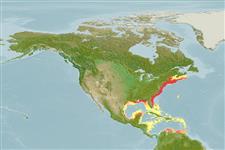分類 / Names
俗名 | 同種異名 | Catalog of Fishes(屬, 種) | ITIS | CoL | WoRMS | Cloffa
Teleostei >
Perciformes/Scorpaenoidei (Scorpionfishes)
鮋形目 (Scorpionfishes) >
Triglidae (Searobins)
角魚科 (Searobins) > Prionotinae
Etymology: Prionotus: Greek, prion, -onos = saw + Greek, noton = back (Ref. 45335).
More on author: Linnaeus.
Environment: milieu / climate zone / depth range / distribution range
生態學
海洋; 半鹹淡水 居於水底的; 深度上下限 15 - 170 m. 溫帶; 46°N - 10°N, 98°W - 60°W
Western Atlantic: Nova Scotia in Canada to central Florida in USA. Gulf of Mexico (Ref. 26938).
西大西洋: 對中央的美國佛羅里達的加拿大的新斯科舍省。 墨西哥灣.(參考文獻 26938)
大小 / 重量 / 年齡
Maturity: Lm ? range ? - ? cm
Max length : 38.0 cm TL 雄魚/尚未辨別雌雄; (Ref. 7251); common length : 30.0 cm TL 雄魚/尚未辨別雌雄; (Ref. 3822)
Occurs on sandy bottom. Feeds on shrimps, crabs, other crustaceans, squid, bivalves and small fishes. Produces loud, drumming sound by vibrating its swim bladder (Ref. 9988). Used both for food and fish meal; other uses include bait for lobster traps and flatfish, handlines, pet food and fertilizer. Utilized fresh and frozen; also used for caviar ; can be broiled and baked (Ref. 9988).
生活於沙質底部。 吃蝦,螃蟹,其他的甲殼動物,烏賊,二枚貝與小魚。 產生大聲的, 打鼓聲音藉由振動它的泳鰾。 (參考文獻 9988) 使用過的由於食物與魚粉; 其他的使用為龍蝦魚籠與比目魚,手執的釣絲,寵物飼料與肥料包括誘餌。 生鮮使用與冷凍; 也用來魚子醬 ; 能被火烤而且燒烤。 (參考文獻 9988)
Life cycle and mating behavior
成熟度 | 繁殖 | 產卵場 | 卵 | 孕卵數 | 仔魚
Oviparous (Ref. 37799).西大西洋: 對中央的美國佛羅里達的加拿大的新斯科舍省。 墨西哥灣.(參考文獻 26938)
Robins, C.R. and G.C. Ray, 1986. A field guide to Atlantic coast fishes of North America. Houghton Mifflin Company, Boston, U.S.A. 354 p. (Ref. 7251)
人類使用
漁業: 低經濟; 誘餌: occasionally
更多資訊
合作者照片Stamps, Coins Misc.聲音神經毒速度泳型鰓區Otoliths腦重體重比眼睛色素
工具
特別的報告
下載 XML
網路資源
Estimates based on models
Preferred temperature (Ref.
123201): 6.4 - 24.7, mean 18.9 °C (based on 85 cells).
Phylogenetic diversity index (Ref.
82804): PD
50 = 0.5000 [Uniqueness, from 0.5 = low to 2.0 = high].
Bayesian length-weight: a=0.00513 (0.00262 - 0.01005), b=3.19 (3.01 - 3.37), in cm total length, based on LWR estimates for this species & (Sub)family-body (Ref.
93245).
營養階層 (Ref.
69278): 4.1 ±0.0 se; based on diet studies.
Generation time: 3.7 ( na - na) years. Estimated as median ln(3)/K based on 1
growth studies.
回復力 (Ref.
120179): 中等的, 族群倍增時間最少 1.4 - 4.4年 (K=0.3).
Fishing Vulnerability (Ref.
59153): Low to moderate vulnerability (35 of 100).
Nutrients (Ref.
124155): Calcium = 49.7 [26.9, 103.6] mg/100g; Iron = 0.418 [0.221, 0.752] mg/100g; Protein = 16.6 [14.1, 19.5] %; Omega3 = 0.686 [0.305, 1.832] g/100g; Selenium = 14.8 [7.1, 33.4] μg/100g; VitaminA = 22.9 [8.7, 63.4] μg/100g; Zinc = 0.571 [0.403, 0.805] mg/100g (wet weight);
